Introduction to Strategic Plan
Trinity College Botanic Garden has a 333-year history, making it one of the oldest university botanic gardens in the world. As a garden and living collection of plants it has moved three times since its inception as a Physic Garden on Trinity’s main campus in 1687. Today it contains an estimated 4000 species on a multi-acre site at Trinity Hall, about four miles south of the main city centre campus. It is surrounded by many horticulturally-rich Victorian and Georgian gardens and Palmerston Park, in the leafy neighbourhood of Dartry, making this area an urban hot spot of biodiversity. It’s unique setting in a capital city surrounded by green spaces and urban forests, the long history of research links to the Schools of Natural Sciences and Engineering and growing links with the School of Computer Science and Statistics, make it an ideal site to serve as a hub for long-term monitoring of Dublin’s climate, environment and biodiversity.
We have developed a ten-year strategy for the gardens (2020–2030) within the framework of Trinity’s E3 initiative and in line with global policy initiatives such as the Paris Climate Agreement and UN Sustainable Development Goals to address the twin challenges of global climate change and biodiversity loss. The overarching mission of Trinity College Botanic Garden is “to promote the importance and value of plants for future sustainable development through conservation, teaching, research, innovation and outreach”. As part of this mission we aim to use the living collections as a tool for Dublin, and globally, to monitor the impacts of climate change on the environment and species within our city – both native and exotic. We propose to use our living plant collections and a new environmental sensor network within the gardens to track and assess implementation of global, EU and Irish environmental and biodiversity policies. Are they working? Could we do better? We aim to lead by example by striving to adopt zero carbon and zero waste practices and infrastructure as part of our strategic goals. Finally, we are committed to contributing to global conservation efforts by protecting our in situ collections, opening our doors to active collaborations, making digitised collections freely available to all online and welcoming students, teachers and the public to enjoy all facets of our gardens as we expand their reach over the coming decade.

Professor Jennifer McElwain
Director, Trinity College Botanic Garden
Develop a college botanic garden for the 22nd century
- Integrate emerging technology (e.g. solar greenhouses) and green energy (e.g. geothermal) with research excellence in plant and environmental sciences to establish Trinity College Botanic Garden as a national testbed facility for zero-carbon and zero-waste
- Develop new teaching facilities at the garden for undergraduate, postgraduate and extramural courses
- Digitise the estimated 4000 specimens in the living plant collection, and the Irish Threatened Plant Seedbank including important crop wild relatives.
- Assess and update current IUCN conservation status of all plants in the living plant collections and make accessible through open access portals to enhance material exchange and networking of the collection globally
- Focus our conservation efforts on Irish threatened native plants through expansion of our native seed bank holdings and living plant interpretive displays, in line with Target 8 of the Global Strategy in Plant Conservation (to conserve at least 75% of global threatened plant species in ex situ collections, preferably in the country of origin, 2011-2020).
Establish Trinity College Botanic Garden as an urban hub for long-term ecological and environmental monitoring
- Develop a programme of long-term environmental and ecological monitoring in Trinity College Botanic Garden to provide important baseline data to the global community on the impacts of climate change and air quality on selected species in an urban environment
- Design and deploy a ‘smart gardens’ plan to enable long-term biological and environmental monitoring
- Develop open access web portal for long-term monitored environmental and biological data for public download and visualization
- Build interdisciplinary collaboration from within the Trinity College network to co-develop a ‘smart gardens’ network to maximize use for teaching, research and outreach
Use the extensive living plants collection to deliver inclusive education and outreach programs on sustainable futures
- Increase the use of Trinity College Botanic Garden for research-based teaching in the Schools of Natural Sciences, Engineering and Computer Sciences undergraduate and postgraduate programmes
- Make living plant collection meta-data available as an open access resource – to include history of accession, collector, geographic origin, conservation status, high resolution image, etc.
- Expand the extramural course offering through new teaching facilities in the adjacent Trinity Hall student accommodation complex
- Develop outreach programmes for inclusive society engagement
- Develop a summertime paid undergraduate internship programme for Trinity College students
Establish Trinity College Botanic Garden as a financially sustainable teaching and research hub
- Increase funding allocation for Trinity College Botanic Garden from the core School budget
- Increase the external revenue stream to the garden through partnerships with industry/business communities, national and international funding agencies and philanthropic donations
- Develop interdisciplinary collaborations within Trinity College for co-funding research and teaching applications in relation to the college’s E3 (Engineering, Environment and Emerging Technologies) Institute.
- Increase public engagement, particularly with local residents and members of the wider Dartry community
- Increase engagement with Trinity Hall students and wardens

